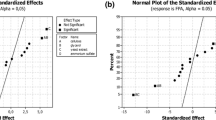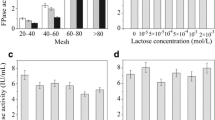Abstract
Chaetomium thermophile var.dissitum, isolated from an experimental urban refuse compost, had the following growth characteristics: Minimum temperature, 27±1°C; optimum, 45–50°C; maximum, 57±1°C; pH optimum 5.5–6.0.
A number of carbohydrates could be used for growth, but cellulase formation measured with carboxymethylcellulose as substrate was initiated only on cellulose or xylan. With cellulose as the carbon source, cellulase accumulation in the culture filtrate followed closely that of growth, when the temperature was varied. pH optimum for the cellulase system was 5.0.
The optimum temperature for cellulase activity with carboxymethylcellulose as substrate varied between 77°C with 1/2 h incubation time and 58°C with 10 h incubation time.
With cotton as substrate, the optimum temperature was 58°C regardless of incubation time. Carboxymethylcellulose had a higher stabilizing effect on the enzyme than cotton. The temperature stability of the cellulase was highest at pH 6.0.
Similar content being viewed by others
References
Chang, Y., Hudson, J. J.: The fungi of wheat straw compost. Brit. Mycol. Soc. Trans.50, 649–677 (1967)
Cooney, D. G., Emerson, R.: Thermophilic fungi. San Francisco-London: Freeman 1964
Fergus, C. L.: The cellulolytic activity of thermophilic fungi and actinomycetes. Mycologia (N.Y.)61, 120–129 (1969)
Fergus, C. L.: The production of amylase by some thermophilic fungi. Mycologia (N.Y.)61, 1171–1175 (1969)
Fergus, C. L., Amelung, R. M.: The heat resistance of some thermophilic fungi on mushroom compost. Mycologia (N.Y.)63, 675–679 (1971)
Gundersen, K.: Mycelium as inoculation material for growth determinations with fungi. Friesa7, 1–9 (1962)
Jennison, M. W., Newcomb, M.D., Henderson, R.: Physiology of wood rotting Basidiomycetes. Mycologia (N.Y.)47, 275–304 (1955)
La Touche, C. J.: On a thermophilic species ofCheetomium. Brit. Mycol. Soc. Trans.33, 94–104 (1950)
Nelson, N.: A photometric adaption of the Somogyi method for the determination of glucose. J. biol. Chem.153, 375–380 (1944)
Osmundsvåg, K., Goksöyr, J.: Cellulases fromSporocytophaga myxococcoides Europ. J. Biochem.57, 405–409 (1975)
Somogyi, M.: Notes on sugar determination. J. biol. Chem.195, 19–23 (1952)
Tansey, M. R.: Experimental studies of thermophilic and thermotolerant fungi. Ph. D. thesis, 235 pp. University Microfilms, a Xerox Company, Ann Arbor. Michigan (1970)
Thomas, R.: Fungal Cellulases. Aust. J. Biol. Sci.9, 159–183 (1956)
Author information
Authors and Affiliations
Rights and permissions
About this article
Cite this article
Eriksen, J., Goksöyr, J. The effect of temperature on growth and cellulase (β-1,4-endoglucanase) production in the compost fungusChaetomium thermophile var.dissitum . Arch. Microbiol. 110, 233–238 (1976). https://doi.org/10.1007/BF00690232
Received:
Issue Date:
DOI: https://doi.org/10.1007/BF00690232




